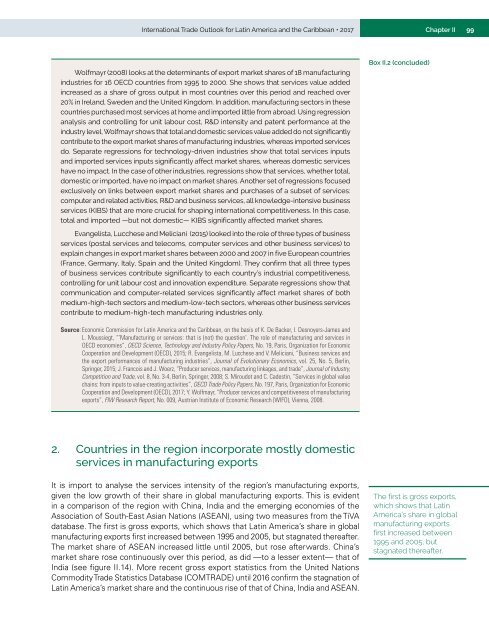International Trade Outlook for Latin America and the Caribbean: Recovery in an uncertain context
This first edition of International Trade Outlook for Latin America and the Caribbean, which is the continuation of Latin America and the Caribbean in the World Economy with a new title, covers 2017 and contains three chapters. The first chapter describes the current international context and the recovery of trade in the region. Chapter II reviews the region’s performance in global trade in services in general and in modern services in particular, since 2005. Chapter III provides an overview of Latin America and the Caribbean’s share of the world agricultural trade since 2000 and offers some policy recommendations for increasing the sector’s contribution to regional development.
This first edition of International Trade Outlook for Latin America and the Caribbean, which is the continuation of Latin America and the Caribbean in the World Economy with a new title, covers 2017 and contains three chapters. The first chapter describes the current international context and the recovery of trade in the region. Chapter II reviews the region’s performance in global trade in services in general and in modern services in particular, since 2005. Chapter III provides an overview of Latin America and the Caribbean’s share of the world agricultural trade since 2000 and offers some policy recommendations for increasing the sector’s contribution to regional development.
You also want an ePaper? Increase the reach of your titles
YUMPU automatically turns print PDFs into web optimized ePapers that Google loves.
<strong>International</strong> <strong>Trade</strong> <strong>Outlook</strong> <strong>for</strong> <strong>Lat<strong>in</strong></strong> <strong>America</strong> <strong><strong>an</strong>d</strong> <strong>the</strong> <strong>Caribbe<strong>an</strong></strong> • 2017<br />
Chapter II<br />
99<br />
Wolfmayr (2008) looks at <strong>the</strong> determ<strong>in</strong><strong>an</strong>ts of export market shares of 18 m<strong>an</strong>ufactur<strong>in</strong>g<br />
<strong>in</strong>dustries <strong>for</strong> 16 OECD countries from 1995 to 2000. She shows that services value added<br />
<strong>in</strong>creased as a share of gross output <strong>in</strong> most countries over this period <strong><strong>an</strong>d</strong> reached over<br />
20% <strong>in</strong> Irel<strong><strong>an</strong>d</strong>, Sweden <strong><strong>an</strong>d</strong> <strong>the</strong> United K<strong>in</strong>gdom. In addition, m<strong>an</strong>ufactur<strong>in</strong>g sectors <strong>in</strong> <strong>the</strong>se<br />
countries purchased most services at home <strong><strong>an</strong>d</strong> imported little from abroad. Us<strong>in</strong>g regression<br />
<strong>an</strong>alysis <strong><strong>an</strong>d</strong> controll<strong>in</strong>g <strong>for</strong> unit labour cost, R&D <strong>in</strong>tensity <strong><strong>an</strong>d</strong> patent per<strong>for</strong>m<strong>an</strong>ce at <strong>the</strong><br />
<strong>in</strong>dustry level, Wolfmayr shows that total <strong><strong>an</strong>d</strong> domestic services value added do not signific<strong>an</strong>tly<br />
contribute to <strong>the</strong> export market shares of m<strong>an</strong>ufactur<strong>in</strong>g <strong>in</strong>dustries, whereas imported services<br />
do. Separate regressions <strong>for</strong> technology-driven <strong>in</strong>dustries show that total services <strong>in</strong>puts<br />
<strong><strong>an</strong>d</strong> imported services <strong>in</strong>puts signific<strong>an</strong>tly affect market shares, whereas domestic services<br />
have no impact. In <strong>the</strong> case of o<strong>the</strong>r <strong>in</strong>dustries, regressions show that services, whe<strong>the</strong>r total,<br />
domestic or imported, have no impact on market shares. Ano<strong>the</strong>r set of regressions focused<br />
exclusively on l<strong>in</strong>ks between export market shares <strong><strong>an</strong>d</strong> purchases of a subset of services:<br />
computer <strong><strong>an</strong>d</strong> related activities, R&D <strong><strong>an</strong>d</strong> bus<strong>in</strong>ess services, all knowledge-<strong>in</strong>tensive bus<strong>in</strong>ess<br />
services (KIBS) that are more crucial <strong>for</strong> shap<strong>in</strong>g <strong>in</strong>ternational competitiveness. In this case,<br />
total <strong><strong>an</strong>d</strong> imported —but not domestic— KIBS signific<strong>an</strong>tly affected market shares.<br />
Ev<strong>an</strong>gelista, Lucchese <strong><strong>an</strong>d</strong> Melici<strong>an</strong>i (2015) looked <strong>in</strong>to <strong>the</strong> role of three types of bus<strong>in</strong>ess<br />
services (postal services <strong><strong>an</strong>d</strong> telecoms, computer services <strong><strong>an</strong>d</strong> o<strong>the</strong>r bus<strong>in</strong>ess services) to<br />
expla<strong>in</strong> ch<strong>an</strong>ges <strong>in</strong> export market shares between 2000 <strong><strong>an</strong>d</strong> 2007 <strong>in</strong> five Europe<strong>an</strong> countries<br />
(Fr<strong>an</strong>ce, Germ<strong>an</strong>y, Italy, Spa<strong>in</strong> <strong><strong>an</strong>d</strong> <strong>the</strong> United K<strong>in</strong>gdom). They confirm that all three types<br />
of bus<strong>in</strong>ess services contribute signific<strong>an</strong>tly to each country’s <strong>in</strong>dustrial competitiveness,<br />
controll<strong>in</strong>g <strong>for</strong> unit labour cost <strong><strong>an</strong>d</strong> <strong>in</strong>novation expenditure. Separate regressions show that<br />
communication <strong><strong>an</strong>d</strong> computer-related services signific<strong>an</strong>tly affect market shares of both<br />
medium-high-tech sectors <strong><strong>an</strong>d</strong> medium-low-tech sectors, whereas o<strong>the</strong>r bus<strong>in</strong>ess services<br />
contribute to medium-high-tech m<strong>an</strong>ufactur<strong>in</strong>g <strong>in</strong>dustries only.<br />
Source: Economic Commission <strong>for</strong> <strong>Lat<strong>in</strong></strong> <strong>America</strong> <strong><strong>an</strong>d</strong> <strong>the</strong> <strong>Caribbe<strong>an</strong></strong>, on <strong>the</strong> basis of K. De Backer, I. Desnoyers-James <strong><strong>an</strong>d</strong><br />
L. Moussiegt, “‘M<strong>an</strong>ufactur<strong>in</strong>g or services: that is (not) <strong>the</strong> question’. The role of m<strong>an</strong>ufactur<strong>in</strong>g <strong><strong>an</strong>d</strong> services <strong>in</strong><br />
OECD economies”, OECD Science, Technology <strong><strong>an</strong>d</strong> Industry Policy Papers, No. 19, Paris, Org<strong>an</strong>ization <strong>for</strong> Economic<br />
Cooperation <strong><strong>an</strong>d</strong> Development (OECD), 2015; R. Ev<strong>an</strong>gelista, M. Lucchese <strong><strong>an</strong>d</strong> V. Melici<strong>an</strong>i, “Bus<strong>in</strong>ess services <strong><strong>an</strong>d</strong><br />
<strong>the</strong> export per<strong>for</strong>m<strong>an</strong>ces of m<strong>an</strong>ufactur<strong>in</strong>g <strong>in</strong>dustries”, Journal of Evolutionary Economics, vol. 25, No. 5, Berl<strong>in</strong>,<br />
Spr<strong>in</strong>ger, 2015; J. Fr<strong>an</strong>cois <strong><strong>an</strong>d</strong> J. Woerz, “Producer services, m<strong>an</strong>ufactur<strong>in</strong>g l<strong>in</strong>kages, <strong><strong>an</strong>d</strong> trade”, Journal of Industry,<br />
Competition <strong><strong>an</strong>d</strong> <strong>Trade</strong>, vol. 8, No. 3-4, Berl<strong>in</strong>, Spr<strong>in</strong>ger, 2008; S. Miroudot <strong><strong>an</strong>d</strong> C. Cadest<strong>in</strong>, “Services <strong>in</strong> global value<br />
cha<strong>in</strong>s: from <strong>in</strong>puts to value-creat<strong>in</strong>g activities”, OECD <strong>Trade</strong> Policy Papers, No. 197, Paris, Org<strong>an</strong>ization <strong>for</strong> Economic<br />
Cooperation <strong><strong>an</strong>d</strong> Development (OECD), 2017; Y. Wolfmayr, “Producer services <strong><strong>an</strong>d</strong> competitiveness of m<strong>an</strong>ufactur<strong>in</strong>g<br />
exports”, FIW Research Report, No. 009, Austri<strong>an</strong> Institute of Economic Research (WIFO), Vienna, 2008.<br />
Box II.2 (concluded)<br />
2. Countries <strong>in</strong> <strong>the</strong> region <strong>in</strong>corporate mostly domestic<br />
services <strong>in</strong> m<strong>an</strong>ufactur<strong>in</strong>g exports<br />
It is import to <strong>an</strong>alyse <strong>the</strong> services <strong>in</strong>tensity of <strong>the</strong> region’s m<strong>an</strong>ufactur<strong>in</strong>g exports,<br />
given <strong>the</strong> low growth of <strong>the</strong>ir share <strong>in</strong> global m<strong>an</strong>ufactur<strong>in</strong>g exports. This is evident<br />
<strong>in</strong> a comparison of <strong>the</strong> region with Ch<strong>in</strong>a, India <strong><strong>an</strong>d</strong> <strong>the</strong> emerg<strong>in</strong>g economies of <strong>the</strong><br />
Association of South-East Asi<strong>an</strong> Nations (ASEAN), us<strong>in</strong>g two measures from <strong>the</strong> TiVA<br />
database. The first is gross exports, which shows that <strong>Lat<strong>in</strong></strong> <strong>America</strong>’s share <strong>in</strong> global<br />
m<strong>an</strong>ufactur<strong>in</strong>g exports first <strong>in</strong>creased between 1995 <strong><strong>an</strong>d</strong> 2005, but stagnated <strong>the</strong>reafter.<br />
The market share of ASEAN <strong>in</strong>creased little until 2005, but rose afterwards. Ch<strong>in</strong>a’s<br />
market share rose cont<strong>in</strong>uously over this period, as did —to a lesser extent— that of<br />
India (see figure II.14). More recent gross export statistics from <strong>the</strong> United Nations<br />
Commodity <strong>Trade</strong> Statistics Database (COMTRADE) until 2016 confirm <strong>the</strong> stagnation of<br />
<strong>Lat<strong>in</strong></strong> <strong>America</strong>’s market share <strong><strong>an</strong>d</strong> <strong>the</strong> cont<strong>in</strong>uous rise of that of Ch<strong>in</strong>a, India <strong><strong>an</strong>d</strong> ASEAN.<br />
The first is gross exports,<br />
which shows that <strong>Lat<strong>in</strong></strong><br />
<strong>America</strong>’s share <strong>in</strong> global<br />
m<strong>an</strong>ufactur<strong>in</strong>g exports<br />
first <strong>in</strong>creased between<br />
1995 <strong><strong>an</strong>d</strong> 2005, but<br />
stagnated <strong>the</strong>reafter.


















